Born in Iran and brought up in Pakistan, artist Nida Bangash earned her BFA and MA (with honors) at The College of Arts, Lahore, Pakistan, where she taught before relocating to the United States in 2013. An esteemed artist and academic overseas, she gave up her career to move with her husband and family to Dallas, only to start over. As someone who has moved many times and had to start and restart my career, I celebrate her tenacity and perseverance.
She is now a full-time artist focusing on her art practice, her family, and community projects such acting as the C3 Visiting Artist at DMA (toward the end of this year), and outreach art projects for refugee children in the Dallas area.
A solo show of Bangesh’s work, titled The History House, is currently on view at Talley Dunn Gallery in Dallas. This interview has been edited slightly for length and clarity.
Colette Copeland: In Lahore, Pakistan, before moving to Texas, you worked as a Professor and Coordinator of the MA Visual Arts Program. What made you decide to pursue your MFA [at SMU] here?
Nida Bangash: I gave up my job as an Assistant Professor at The National College of Arts Lahore to move to the U.S. with my husband seven years ago. For five years I struggled with finding footing as a teacher in colleges and universities in the Dallas area. Upon meeting the chair of various departments, they would look at my degree and say, well you do have an MA (Hons.) in Visual Arts which is basically a British equivalent of an MFA, and you do have teaching experience but … we need an MFA. Do apply and we will see what we can do. And then … crickets. In time I realized that in order to teach in this system, I would have to be a certified product of it.
This is an old, much-repeated story, across different fields of work. Take my sister’s story for instance, not unique in any way I assure you. She was a practicing gynecologist in one of the best hospitals in Pakistan. She moved to Canada seven years ago and had to start all over again, from scratch! She is currently being bullied around in Detroit by resident doctors half her age, for having an accent that doesn’t sound American. We all have to start from scratch: our homes, our families, our language, our communities, our careers. We are thrown back decades, not because we know any less or because we are less capable, but because we have to. It’s the air we breathe.
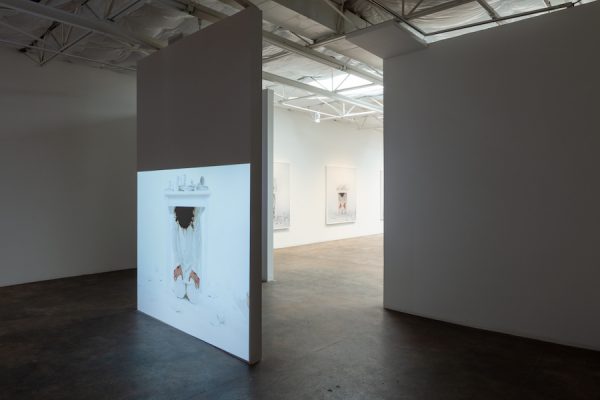
Installation view of Nida Bangash: The History House, on view at Talley Dunn Gallery, Dallas. Photo: Kevin Todora.
CC: Trained in the traditions of Persian and South Asian miniature painting, your repertoire now includes performance and video. Tell us about your decision to expand into performance. How has that shaped or transformed your practice?
NB: I have been trained in an institutionalized version of what was once called fanne-musawri. The National College of Arts, Lahore was originally founded in 1875 as the Mayo School of Industrial Arts, and was one of two art colleges created by the British Crown in British India in reaction to the Arts & Crafts Movement. The term “miniature painting” was changed from fanne-musawri during the British era and now we associate the whole genre with this term. The Arabic word fanne-musawri is one of the 99 names of God that is used self-reflexively in the Quran as the curator/artist. This word entered India through Persian language. The local term connects the painter to the Devine archetype of the creator, whereas the reductive materialistic term “miniature” merely describes the art from its physical attributes. These interruptions have morphed this genre into something I can’t call traditional anymore. What I am trying to reconcile now is what me and my colleagues learned at NCA — what has never been traditional in a true sense, because we institutionalized and modernized it to fit a certain palette, to call it contemporary art.
Crossing disciplines has been part of my practice [from] early on; I worked with performance and video installations right after my undergrad when I embarked on a grad program directed by Lala Rukh. She guided me along the way to push the limits of my practice, at the same time exposing us to a wide range of practitioners such as classical musicians, singers, dancers, calligraphers, carpet weavers, women activists, writers, and so forth, which helped me understand the true essence of musawri, which is far beyond the limitations of medium or size.
As I see it, my practice weaves painting, performances and moving images in the way they are constructed and rendered. I see my paintings as a very slow-motion video, constantly changing and shifting. At the same time, my videos resonate the stillness of a painting. I use a single point of view and bare minimum editing techniques, blurring the boundaries between these disciplines in my practice. In the construction of the visuals, I seek to make complex subjects simple without making them simplistic.
CC: The current show at Talley Dunn, titled History House, explores the legacy of colonialism using the domestic tropes of the bed, the table and the roof. Explain your use of the domestic sphere to address socio-political themes.
NB: Coming from a miniature painting and carpet-weaving background, my interest lies in the formal and conceptual underpinnings of the grid — a binary structure of power — which bears, gives form to, and disappears into the composition itself.
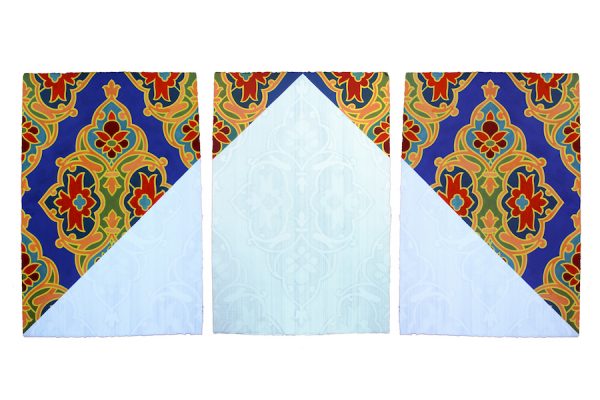
Nida Bangash, Roof I, 01, 2019. Gouache and silver point on paper, set of three panels 15X22 inches each.
Running across multiple panels is tessellating Toranj pattern, which at its base is rendered conspicuously into a triangular, white roof. This triangle is painted with two white pigments, titanium and zinc, over which vertical lines (evoking the warp of an unfinished carpet) are drawn with copper and silver points, causing the drawing to constantly tarnish, transform and [be] unstable. Stability lays beyond the fragile roof in the bright colors that form the background.
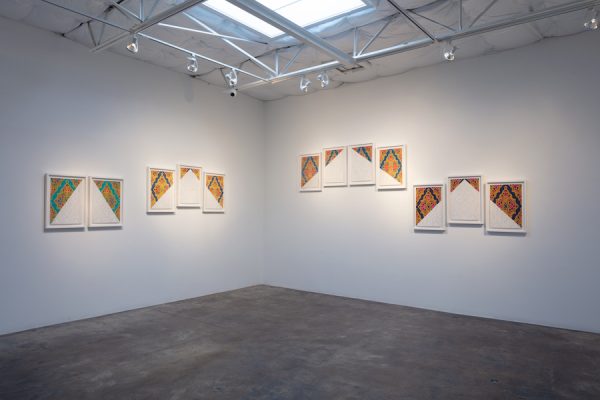
Installation view of Nida Bangash: The History House, on view at Talley Dunn Gallery, Dallas. Photo: Kevin Todora.
The image of a home in my work references my early childhood drawings of houses, which strangely present a western European archetype of a house in visual culture: a rectangle with two windows and a door, a triangular pitched roof, and a chimney. Despite the fact that many houses globally do not resemble this form, this image has become a universal symbol for “home,” unconsciously internalized and reproduced by children all over the world. Along with my feminist engagement with and critique of the domestic space, this image of “the house” resonates with postcolonial conditions — particularly questions of cultural imperialism, territoriality, exile and dislocation.
CC: The two performance video works on display at Talley Dunn — Bridge Called My Back and Sight_Plan — both incorporate the female body as architecture, as well as a powerful symbol of resistance. In these works, your body is the structure which holds the weight of the colonizer, yet what interests me is how the works show the complicity between the colonizer and the colonized. One cannot exist without the other. Tell us more about this, and the “hidden” aspect of the body in Sight_Plan.
NB: Sight_Plan is a two-channel video installation which presents two different points of views of a single performance. Displayed on a wall is a monitor in which the viewer encounters the first video, a bird’s eye view of tea-stained, imperial white china tea cups being stacked on a white table by an anonymous group of people dressed in white. As the cups pile up, they fall and eventually break, but the stacking continues. The second video, projected on the other side on the wall, is a frontal view of the performance in which I am kneeling down, clad in white, holding the table upon which the cups are being stacked for the entire duration of the video.
On the one hand, this work speaks of the expected domestic roles that ultimately render invisible both the body and its labor, and underscores the un-attainability of the domestic ideals. On the other hand, it speaks of invisibilized people and structures of labor in larger society, in general. “Invisibility is not a natural state for anyone.” I am literally shattering the products of colonialism and the objects and consumables that were so deeply entrenched in “Empire” that they have lost their origins through colonialism and have become symbols of the colonizers. Neither porcelain nor tea were European products, and yet the quintessential British act is drinking tea out of fine china. Tea is now British. And despite it holding onto the place-name from where it came, china is apparently British as well — a symbol of finery.
Titled after a book, This Bridge Called my Back is an anthology of artworks, essays and poems of a self-described group of “radical women of color,” first published in 1981. It is a five-channel video installation, in which I am on all fours, balancing on my back both a bench and a man, in five different locations. While on the one level this work is a visual representation of the weight of responsibilities and obligations I, as woman, wife, mother, and daughter carry on my shoulders every day, on another level it speaks of our roles that revolve around a center which is defined by western norms, and that is the weight we have been carrying for centuries. As a South Asian woman, I feel strongly towards Spivak’s writings, as she expands the historical research of Subaltern Studies histories by focusing the experiences of subaltern woman. She speaks of the impossibility of reclaiming and re-writing history in the western framework as they construct “truth” for us. Western institutions speaking on behalf of the subaltern woman silences her by speaking of her experience. But you can hear my heart beat and my breath in this installation, as you can hear the shattering of the teacups and my exhausted breath in Sight_Plan. I am not silent.
In these works, I reference the still-whitewashed Tomb of Anarkali in Lahore — built by the Mughal Emperor Jahangir (Prince Saleem) as a memorial for his lover Anarkali, who was executed in 1599 after being accused of having an illicit love affair with young Prince Saleem. It served the British Raj as clerical offices (1847), then the Anglican St. James Church (1851), and then the Punjab Record Office (1891). It remains the Punjab Archives, and this is not uncommon as today postcolonial local governments in the sub-continent have often had to continue in the footprints left by the Raj. In This Bridge Called My Back, my body is holding a structure on which a white man sits, and in Sight_Plan, my body is holding a structure on which imperial white china cups stained with tea are being stacked, referencing to the fact that my body is trained to do the labor of holding that structure intact. That is why as a society we still buy whitening creams; we still have to speak a certain language or walk a certain walk to be considered “fit” enough. It’s in our system.
CC: One of the things I love about living in this area (of DFW) is the cultural diversity, especially the large South Asian population. But many of my students have shared with me that they have experienced a lot of prejudice and racism living in the area. What has been your biggest challenge as an Iranian/Pakistani woman living here?
NB: There is indeed a lot of cultural diversity to be found in the greater DFW Metroplex. Frisco, Plano and the Irving area host large South Asian communities. Richardson and Plano are home to a large Iranian community, but immigrant communities exist in tight-knit pockets, so while DFW on the whole has a diverse population, not all areas of Dallas can be considered diverse.
At SMU, I stuck out like a sore thumb. Racism at SMU ranges from the overt variety, such as the 2017 hate flyers (featuring a caucasian family) all around campus that read “you will not replace us” or “Go back to where you came from,” to a more subtle variety, such as a lack of representation of people of color on the decision table. I didn’t see myself represented in faculty or curriculum. Rarely was any professor or student familiar with books or theories that I had read, or was critically engaged with issues I was exploring. I was criticized for being too decorative, too political, too interdisciplinary, and finally, in my final term oral presentation, I was asked: “Why are you so angry?” I think that sums it up.
I don’t waste my time making work on issues that I don’t deeply care about, or issues that don’t hit home very closely. The works I made there, that are now presented in The History House, were in direct response to what I experienced at SMU. I am so grateful for that opportunity, because my work and my voice have become stronger.
CC: You worked as a photographer for Pakistan Children’s Television on Sesame Street, in Lahore. I can imagine that as either the coolest or most frustrating job ever.
NB: It was hands down the best job I have ever had! Sim Sim Hamara — Pakistani Sesame Street — was a USAID project in collaboration with Sesame workshop and Rafee Peer Theater workshop. I was appointed as a photographer, which meant that I was in every department there was, from script writing, puppet making, costume design, and set design, to music productions, the animation department, editing department, backstage, and of course the set where all the filming magic happened. I had to document it all to keep records. It was a truly interdisciplinary creative hub where I got to work with so many extraordinary, talented people, who made amazing things happen. I grew up watching Sesame Street, but it was so amazing to see brown puppets being conceived and produced. A whole cast of new muppets — Haseen-o-Jameel, a flamboyant crocodile; Baji, a traditional Pakistani woman with a passion for nutrition; Rani, the six-year-old, science-crazy schoolgirl curious about local culture, with storylines that promoted tolerance and respect. Elmo was speaking my language: Urdu! It was amazing! Truly a stuff of dreams.
CC: The exhibition title references Arundhati Roy’s novel The God of Small Things. How has that book influenced your work?
NB: Not only that book, but Arundhati Roy as a writer and person profoundly inspires and influences my practice. I am not good with words, so her fiction and nonfiction really helps me explain my ideas in so many ways.
In The God of Small Things, The History House is a symbolic representation of the history of Subcontinent; it stands as a symbol of colonialism on nation’s history. I care for how she explains it, so I’m going to quote her instead of butchering her writing. Chacko, a character in the novel, explains that “to understand history … we have to go inside and listen to what they’re saying. And look at the books and the pictures on the wall. And smell the smells.” And later, “we can’t go in … because we’ve been locked out. And when we look in through the windows, all we see are shadows. And when we try and listen, all we hear is a whispering.”
The way it ties up the works in the exhibition for me is the fact that simply seeing the house is not enough to really comprehend the past. History is not a linear process; it is a a deeply sediment, convoluted and whitewashed series of events and understanding. It requires peeling those myths, layer by layer, on a deep, individual level. But this process is not easy, because we have been lost — “locked out” of our own house.
CC: What do you hope viewers will take away from your work?
NB: To quote Arundhati Roy: “As a novelist, I never want to write about ‘issues’ like ‘the Indian family.’ What I want to write about is the air we breathe. These days, I feel that novels are becoming kind of domesticated. They have a title, and a theme, and they are branded just like NGOs: you are writing on gender, you are writing on caste, you are writing on whatever. But for me, the fact is that these are not ‘issues’ — this is the air we breathe.”
My practice at its core is sourced from the “air we breathe.” It speaks of both an intimate, contemplative, and personal space as it meditates power, hierarchies and structures. It speaks of the uncomfortable; it makes viewers uncomfortable because uncomfortable is the air I breathe.
A solo show of Bangash’s work, titled The History House, is on view at Talley Dunn Gallery in Dallas through Feb. 22.


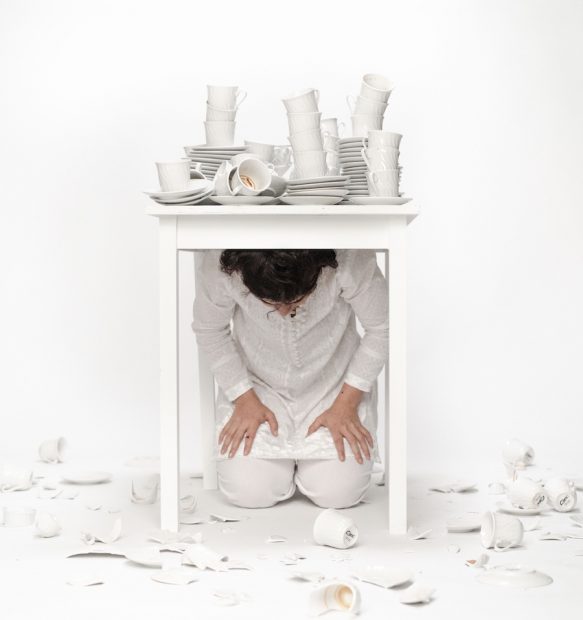
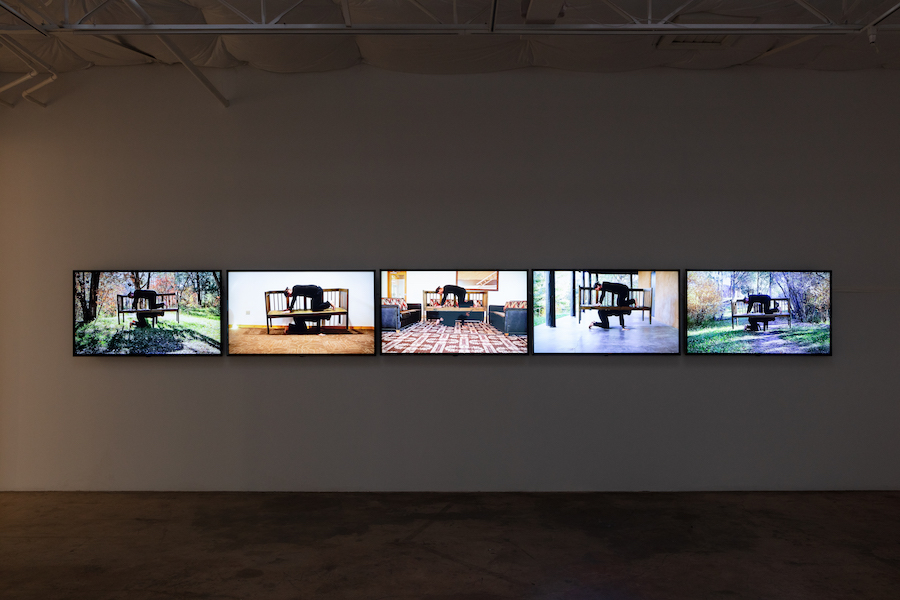




3 comments
I am grateful to have worked with Nida Bangash, an experienced artist who taught me to understand the structures of prejudice deeply. Such systems of cultural life are deeply rooted in every person, and it is the task of the artist to see through the sedimentations of commonplace platitudes and grip these roots and tear them out, at wounding personal cost and endurance.
Barnaby–Thank you for taking the time to respond to Nida’s words and for sharing your experiences about Nida’s impact on your life. The sentence, “…it is the task of the artist to see through the sedimentations of commonplace platitudes, grip the roots and pull them out,” beautifully and profoundly speaks to the role of the artist in our culture today, not only as a witness, but as an activist promoting radical change. Nida’s work does this with grace and a healthy dose of subversive humor.
Colette, how nice to have a response. Nida’s and my discussions involved much humor, and I am delighted that you have seen this in my brief remarks. Thank you.